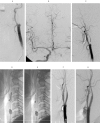Technique and Clinical Results of Carotid Stenting under Distal Protection
- PMID: 20587246
- PMCID: PMC3522218
- DOI: 10.1177/15910199040100S207
Technique and Clinical Results of Carotid Stenting under Distal Protection
Abstract
We perfomed carotid artery stenting(CAS) in 215 patients from August 1997 to October 2003 mainly using the distal protection technique. Our technique and clinical results are described in this paper.
Figures

References
-
- Albuquerque FC, Teitelbaum GP, et al. Balloon-protected carotid angioplasty. Neurosurgery. 2000;46:918–923. - PubMed
-
- Eckert B, Thie A, et al. H: Transcranial Doppler sonographic monitoring during percutaneous transluminal angiopalsty of the internal carotid artery. Neuroradiology. 1997;39:229–234. - PubMed
-
- Golledge J, Mitchell A, et al. Systemic comparison of the early outcome of angiopalsty and endarterectomy for symptomatic carotid artery disease. Stroke. 2000;31:1439–1443. - PubMed
-
- Henry M, Amor M, et al. Angioplasty and stenting of the extracranial carotid arteries. J Endovasc Surg. 1998;5:293–304. - PubMed
-
- Kastrup A, Groschel K, et al. Early outcome of carotid angioplasty and stenting with and without cerebral protection devices: a systemic review of the literature. Stroke. 2003;34:813–819. - PubMed
LinkOut - more resources
Full Text Sources

